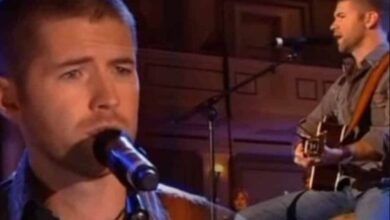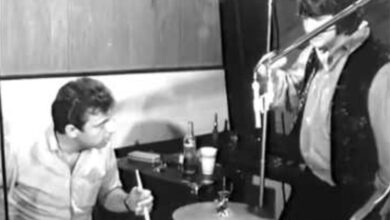Everyone Knew This Dance In The 1950s, Can You Remember It Now
In February 1958, a dance craze swept through American high school gyms and sock hops, capturing the youthful spirit of the era and embodying the carefree energy of the burgeoning rock ‘n’ roll culture. This dance was none other than “The Stroll,” a line dance that became synonymous with fun and spontaneity. Originating from African American communities, “The Stroll” was popularized through the burgeoning influence of television, specifically on Dick Clark’s “American Bandstand,” where teenagers across the country saw the dance and eagerly imitated it at their local gatherings.
“The Stroll” was more than just a dance; it was a cultural phenomenon that reflected the social dynamics of the 1950s. The dance featured two lines of participants facing each other, creating an aisle down the middle. Couples would take turns strutting down the aisle in time to the music, often adding their flair and personality to their movements. This dance was unique in its structure, allowing for both group participation and individual expression, which resonated deeply with the youth of the time who were beginning to carve out their identities within the social fabric.
The song that accompanied this dance was aptly named “The Stroll,” performed by the Canadian vocal group The Diamonds. This doo-wop group, known for their smooth harmonies and catchy tunes, played a pivotal role in bringing the dance to mainstream audiences. The Diamonds’ version of “The Stroll” was not just a hit song; it was the soundtrack to a movement, encapsulating the joy, rebellion, and communal spirit of the era. The group’s charismatic lead singer, Dave Somerville, with his rich baritone voice, became the voice of this movement, guiding dancers with his melodic crooning.
The popularity of “The Stroll” spread like wildfire, and it wasn’t long before it became a staple at dance events. Its appeal was universal, transcending racial and social boundaries at a time when the United States was deeply segregated. The dance’s simplicity made it accessible, while its inherent coolness made it irresistible. Teenagers, eager to be part of the latest trend, would gather in their finest outfits, ready to take their turn strolling down the aisle with a confidence that mirrored the optimism of post-war America.
As “The Stroll” became a nationwide craze, it influenced other aspects of pop culture, including fashion and music. The sight of young people, neatly dressed and moving in sync to the beat, became an iconic image of the 1950s. The dance was often featured in movies, television shows, and even advertisements, solidifying its place in the cultural lexicon. It wasn’t just a dance; it was a symbol of the era’s vibrancy and the beginning of a youth culture that would continue to evolve in the coming decades.
The Diamonds, who initially gained fame with their hit “Little Darlin’,” found their place in music history with “The Stroll.” The success of this song and dance cemented their status as one of the leading doo-wop groups of the time. Their ability to connect with the youth through relatable, catchy music was key to their enduring legacy. The group’s tight harmonies and energetic performances made them favorites on the radio and in live performances, where they would often encourage the audience to join in the dance, creating a shared experience that was both joyous and unifying.
While “The Stroll” was a defining moment in the 1950s, its influence extended beyond the decade. The dance’s structure laid the groundwork for future line dances that would become popular in the 1960s and beyond, such as “The Twist” and “The Hustle.” Even today, “The Stroll” is remembered fondly by those who lived through the era and continues to be celebrated in retro-themed events and dance halls, where the joy of the 1950s is revived through its simple yet infectious movements.
In many ways, “The Stroll” represents the essence of the 1950s—a time of innocence, optimism, and burgeoning social change. It was a dance that brought people together, regardless of background, in a shared moment of joy and expression. The Diamonds, with their contribution to this cultural moment, ensured that “The Stroll” would not just be a fleeting trend but a lasting symbol of an era where music and dance were at the heart of the social experience. The legacy of “The Stroll” lives on, a joyful reminder of the power of music to unite and uplift, even in the simplest of dances.





